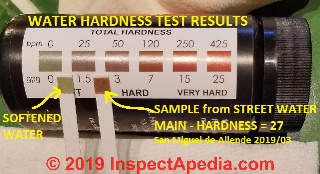 How to Use Water Hardness Test Strips
How to Use Water Hardness Test Strips
Water hardness test results: San Miguel de Allende, Mexico
- POST a QUESTION or COMMENT about how to measure the hardness or mineral content of water
Here we give a step by step description of how to measure water hardness using simple test strips provided in an inexpensive water hardness test kit.
We test the hardness of the water supply for San Miguel de Allende in Guanajuato, Mexico and give the results here.
This article series explains how to measure water hardness or grains of hardness: a measure of water mineral content. We provide a table of water hardness measurements and we discuss different methods for measuring water hardness including a simple soap test.
InspectAPedia tolerates no conflicts of interest. We have no relationship with advertisers, products, or services discussed at this website.
- Daniel Friedman, Publisher/Editor/Author - See WHO ARE WE?
How to Use a Simple Water Hardness Test Kit - Test Strips
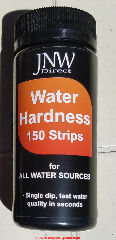 We used the JNW Direct water hardness test kit strips (Amazon.com) to test the hardness level of the water supply in San Miguel de Allende, Guanajuato Mexico (Col. San Antonio) in March of 2019. The test procedure and test results are given here.
We used the JNW Direct water hardness test kit strips (Amazon.com) to test the hardness level of the water supply in San Miguel de Allende, Guanajuato Mexico (Col. San Antonio) in March of 2019. The test procedure and test results are given here.
[Click to enlarge any image]
Test Strip Measurement of Water Hardness
Test strips are typically produced from plastic, with chemically impregnated pads on the end. These pads are designed to react with specific ions and produce a specific color change.
Once a test strip is reacted and a color is developed, the strip is then compared to a printed color chart. The color chart is specifically designed to represent color reactions at various concentrations.
Matching the strip to the closest color match produces a concentration reading [such as those shown at the top of this page] - retrieved 12/11/2014, original source: http://www.lamotte.com/en/blog/test-factors/75-measuring-water-hardness
Sources of water hardness test kits and a description of the accuracy and utility of different water hardness measurement methods are given
at WATER HARDNESS: HOW TO MEASURE.
Steps to Use a Water Hardness Test Strip
- Choose the water source:
Incoming water hardness: if you want to test the hardness of the incoming water supply, find a faucet or water source that will draw water before it has passed through building water treatment equipment, such as at an outdoor water faucet.
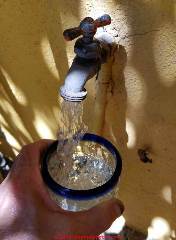
Watch out: do not take your water sample through a garden hose as doing so risks adding additional contaminants that are not innate in the water supply itself. Run water long enough that its temperature has dropped to a stable level, suggesting that you've obtained water from the water supply not standing water from building water pipes.
Treated water hardness: If you want to confirm that your water softener is working and is producing soft water, find a faucet or water source that will draw water after it has passed through the water softener and other building water treatment equipment.
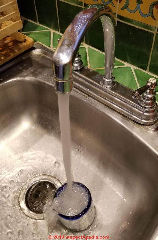
- Select a water hardness test strip from the sealed bottle or envelope. Take care not to touch the sensing pad on the hardness test strip as you don't want to contaminate it or interfere with its sensitivity or chemistry.
- Dip the Test Strip into the water to be tested (we used a clean glass for the water sample) for 2 seconds (or other time as directed by your hardness test kit instructions).
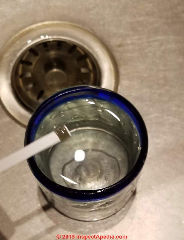
Then shake off excess water so that the sensor tip is left wet but not with a bubble of standing water over it (as shown in our photo above.)
Don't leave the test strip too long in the sample water nor in running water or you may dilute and interfere with its chemistry, thus you'd produce erroneous water hardness test results. - Hold the test strip level (horizontally) for 10-30 seconds to allow the chemical reaction to take place on the test strip sensor pad.
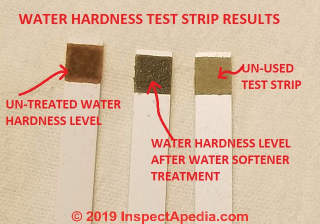
- Read the water hardness by color comparison of the test pad on your sensor strip with the water hardness color indicating scale provided by your test kit manufacturer. These colors will vary depending on whose water hardness test kit you are using.
We used test strips included in a water hardness test kit provided by JNW Direct and sold at Amazon to test water hardness in San Miguel de Allende, Guanajuato, Mexico, in March 2019.
Using the test strips as directed, we compared the water hardness of un-treated water from the street water main with water hardness level after that same water supply had passed through a water treatment system that includes a water softener described separately
at WATER SOFTENER RESIN REPLACEMENT where we describe the installation of a new water softener in San Miguel de Allende.
Un-treated water in San Miguel de Allende has a hardness level of about 27 as shown on our test strip at right in our photo above.
Water after having passed through the water softener and other water treatment equipment at our test site (Col. San Antonio) had a hardness level of about zero (at left in the photo above).
Sources of water hardness tests and kits are
at WATER HARDNESS TEST KIT SOURCES
...
Continue reading at WATER HARDNESS: HOW TO MEASURE or select a topic from the closely-related articles below, or see the complete ARTICLE INDEX.
Or see these
Recommended Articles
- AIR QUALITY STUDY San Miguel de Allende
- ARSENIC in DRINKING WATER
- WATER HARDNESS: HOW TO DETECT
- WATER SOFTENERS & CONDITIONERS - home
- WATER SOFTENER RESIN REPLACEMENT in San Miguel de Allende
- WATER QUALITY & QUANTITY San Miguel de Allende
Suggested citation for this web page
WATER HARDNESS TEST San Miguel de Allende at InspectApedia.com - online encyclopedia of building & environmental inspection, testing, diagnosis, repair, & problem prevention advice.
Or see this
INDEX to RELATED ARTICLES: ARTICLE INDEX to WATER TREATMENT SYSTEMS
Or use the SEARCH BOX found below to Ask a Question or Search InspectApedia
Ask a Question or Search InspectApedia
Questions & answers or comments about how to measure the hardness or mineral content of water
Try the search box just below, or if you prefer, post a question or comment in the Comments box below and we will respond promptly.
Search the InspectApedia website
Note: appearance of your Comment below may be delayed: if your comment contains an image, photograph, web link, or text that looks to the software as if it might be a web link, your posting will appear after it has been approved by a moderator. Apologies for the delay.
Only one image can be added per comment but you can post as many comments, and therefore images, as you like.
You will not receive a notification when a response to your question has been posted.
Please bookmark this page to make it easy for you to check back for our response.
IF above you see "Comment Form is loading comments..." then COMMENT BOX - countable.ca / bawkbox.com IS NOT WORKING.
In any case you are welcome to send an email directly to us at InspectApedia.com at editor@inspectApedia.com
We'll reply to you directly. Please help us help you by noting, in your email, the URL of the InspectApedia page where you wanted to comment.
Citations & References
In addition to any citations in the article above, a full list is available on request.
- [1] North Dakota Standards for Water Softeners, North Dakota General Authority Law, Chapter 62-04-08, Water Softener Units http://www.legis.nd.gov/information/acdata/pdf/62-04-08.pdf. "The objective of this chapter is to provide a standard of quality, capacity, and performance for water softener units. Water softener performance is to be based upon referee tests procedures described in section 62-04-08-09."
- [2] Culligan Mark 10 Water Softener 1994-1998 Installation and Operating Instructions (covering models manufactured after 1995) (1-96) 01881948.pdf available from www.culligan.com
- [3] Water Softeners, CMHC, Canadian Mortgage and Housing Corporation, cmhc-schl.gc.ca/en/co/maho/wawa/wawa_005.cfm - October 2008. Canada Mortgage and Housing Corporation acknowledges the contribution of Health Canada to the development of this document. For further questions regarding water treatment and water quality, contact Health Canada at watereau@hc-sc.gc.ca or call 613-957-2991 or 1-866-225-0709.
- [4] "Commercial Water Softener Installation and Operating Instructions", IBC Filtration & Water Treatment Products (Australia) for commercial, industrial and residential application www.ibcwater.com.au (07) 3219 2233
- [5] "Non electric water softener, Installation and Operating Instructions", IBC Filtration & Water Treatment Products (Australia), op.cit.
- [6] "Water Softener Twin Tank Installation and Operating Instructions", IBC Filtration & Water Treatment Products (Australia), op.cit.
- [7] Our Water Hardness Table used at originated with but was edited and added to from http://www.bestfish.com/tips/110598.html and also from http://www.water-research.net/hardness.htm
- [8] Water Softener with Microprocessor: Installation & Operating Instructions, IBC Filtration & Water Treatment Products (Australia), IBC Water, Ltd., 18 Dividend Street, Mansfield Qld 4122, Postal Address: PO Box 2247, Mansfield BC, Qld 4122 Australia, Tel: Sales/Service: 1-300-166-253; Tel: (07) 3347 1600 Int. +61 7 3347 1600, Facsimile: (07) 3219 2266 Int. +61 7 3219 2266, Email: sales@ibcwater.com.au , web search 01/31/2011, original source: http://www.ibcwater.com.au/zone_files/PDF/as0922mp-cl.pdf
- [9] Taylor Technologies, Inc., 31 Loveton Circle, Sparks, MD 21152-9206. Tel: 800-TEST KIT (837-8548), Taylor Technologies distributes an extensive range of water testing chemicals, methods, technologies. Web search 7/27/2012, Website: http://www.taylortechnologies.com
- Our recommended books about building & mechanical systems design, inspection, problem diagnosis, and repair, and about indoor environment and IAQ testing, diagnosis, and cleanup are at the InspectAPedia Bookstore. Also see our Book Reviews - InspectAPedia.
- In addition to citations & references found in this article, see the research citations given at the end of the related articles found at our suggested
CONTINUE READING or RECOMMENDED ARTICLES.
- Carson, Dunlop & Associates Ltd., 120 Carlton Street Suite 407, Toronto ON M5A 4K2. Tel: (416) 964-9415 1-800-268-7070 Email: info@carsondunlop.com. Alan Carson is a past president of ASHI, the American Society of Home Inspectors.
Thanks to Alan Carson and Bob Dunlop, for permission for InspectAPedia to use text excerpts from The HOME REFERENCE BOOK - the Encyclopedia of Homes and to use illustrations from The ILLUSTRATED HOME .
Carson Dunlop Associates provides extensive home inspection education and report writing material. In gratitude we provide links to tsome Carson Dunlop Associates products and services.

